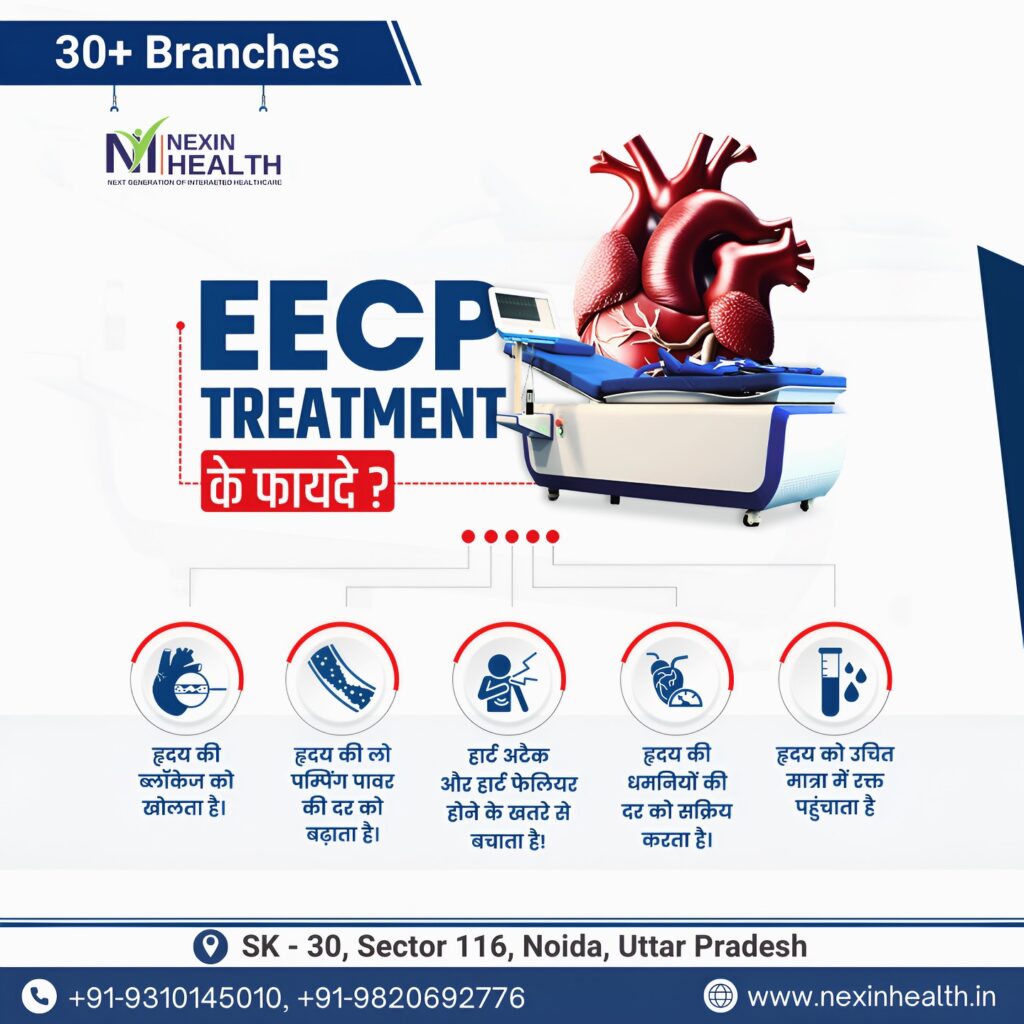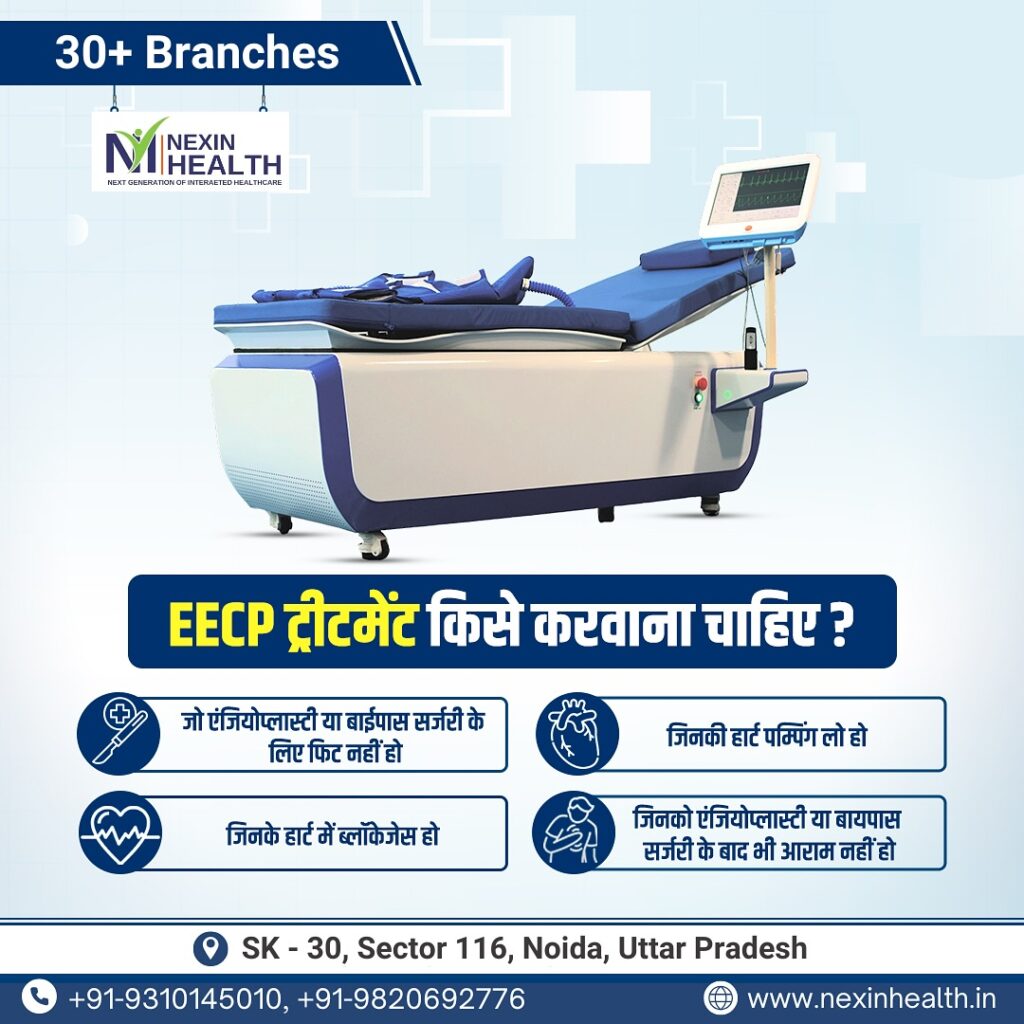How EECP Works to Reduce Chest Pain (Angina)


How EECP Works to Reduce Chest Pain: Chest pain, often referred to as angina, can be a debilitating condition that severely impacts a person’s quality of life. Angina typically occurs due to restricted blood flow to the heart muscle, which is often caused by coronary artery disease. While there are various treatments for managing this condition, Enhanced External Counterpulsation (EECP) is emerging as a non-invasive and effective therapy for reducing chest pain and improving heart health.
In this article, we will delve into how EECP works to reduce chest pain, explore its benefits, and understand why it’s becoming a go-to solution for those suffering from angina. We will also discuss the growing popularity of EECP treatment in India and why it’s worth considering for those in need of heart-related relief.
Enhanced External Counterpulsation (EECP) is a non-invasive treatment that uses a series of air cuffs applied to the legs to improve blood circulation and reduce chest pain caused by angina. The primary goal of EECP is to enhance the flow of oxygenated blood to the heart muscle, allowing the heart to receive the nutrients it needs for optimal function.
EECP is a specialized therapy that involves the use of a device that inflates and deflates pressure cuffs around the lower legs in synchronization with the patient’s heartbeat. This technique works by gently increasing blood flow to the coronary arteries, improving overall heart function, and reducing the symptoms of angina.

The mechanism behind EECP treatment is based on the concept of counterpulsation. Here’s a breakdown of how EECP works to reduce chest pain:
During an EECP session, cuffs placed on the calves, thighs, and buttocks inflate and deflate in sync with the patient’s heartbeat. This action temporarily increases the flow of blood back toward the heart. The primary benefit of this enhanced circulation is an increase in the oxygen supply to the heart muscle, which alleviates the pain caused by poor blood flow (angina).
One of the key benefits of EECP treatment is its ability to stimulate the growth of collateral circulation. Collateral vessels are small blood vessels that develop to bypass blocked or narrowed arteries. By improving blood flow to these vessels, EECP helps create alternative pathways for oxygen-rich blood to reach the heart muscle. This is particularly helpful for patients who have coronary artery disease and suffer from restricted blood flow.
The therapy reduces the workload of the heart by improving the efficiency of blood flow. When blood is delivered more effectively, the heart does not need to work as hard, thereby decreasing myocardial oxygen demand. This reduction in demand can relieve the pain associated with angina, as the heart becomes less stressed during periods of exertion.
EECP helps improve overall cardiovascular health. By promoting better blood circulation, it can lead to improved heart function, reduced symptoms of angina, and potentially better exercise tolerance. Patients may experience a reduction in their need for medications such as nitrates, which are typically prescribed to relieve chest pain.

The benefits of EECP go beyond just reducing chest pain. Here are some of the major advantages of this therapy:
Unlike invasive procedures like angioplasty or coronary artery bypass surgery, EECP is a non-surgical treatment. There are no incisions, no anesthesia, and no need for recovery time. It’s a completely non-invasive procedure, which makes it an attractive option for many patients.
Patients who undergo EECP often report a significant improvement in their quality of life. This includes a reduction in chest pain, better exercise capacity, and increased ability to perform daily activities without discomfort. As the blood flow to the heart improves, individuals are likely to experience less stress, fatigue, and anxiety.
The side effects of EECP are minimal compared to other more invasive treatments. Most patients tolerate the therapy well, and the procedure is generally well-regarded for its safety profile. Some patients might experience mild discomfort or bruising from the cuffs, but these effects are typically temporary.
Many patients who undergo a series of EECP treatments report experiencing long-lasting relief from chest pain. While individual results may vary, the overall benefits can last for months or even years, making it a highly effective long-term solution for managing angina.
Patients undergoing EECP often experience a reduction in the need for medication to manage their angina symptoms. This can mean fewer side effects associated with long-term medication use and an overall improvement in the patient’s well-being.
India has seen a surge in the adoption of EECP treatment, as more healthcare providers recognize its benefits in managing heart disease, particularly for patients suffering from chronic angina. With the rise in heart-related diseases in the country, patients are increasingly looking for non-invasive alternatives to traditional treatments like angioplasty and surgery.

One of the primary reasons EECP has become so popular in India is its affordability compared to invasive heart procedures. In addition, the growing awareness about EECP’s efficacy has led to its widespread use in numerous healthcare facilities across the country. EECP treatment in India has helped thousands of patients experience relief from chest pain, reduced dependency on medications, and improved heart health, without the need for surgery.
1. What conditions can EECP treat?
EECP is primarily used to treat angina (chest pain) caused by coronary artery disease. It can also benefit patients who have heart failure or other cardiovascular issues where improved blood flow is essential.
2. How long does an EECP session last?
An EECP session typically lasts about one hour. During this time, patients are relaxed in a reclining position while the cuffs inflate and deflate in sync with their heartbeat.
3. How many EECP sessions are required for optimal results?
Typically, a full course of EECP consists of 35 sessions, with 5 sessions per week over the course of 7 weeks. However, the number of sessions can vary depending on the individual’s condition and response to treatment.
4. Are there any side effects of EECP?
EECP is generally considered safe, with minimal side effects. Some patients may experience mild bruising or discomfort from the cuffs, but these effects are temporary. Serious side effects are rare.
5. How quickly will I feel relief from chest pain after EECP treatment?
Many patients report noticeable improvements in their chest pain and overall heart health after just a few sessions. However, full benefits may take several weeks to become apparent, as the therapy works to improve blood flow and stimulate collateral circulation.
EECP treatment is a safe, effective, and non-invasive therapy for individuals suffering from angina and other heart-related conditions. By improving blood circulation, promoting the growth of collateral circulation, and reducing the workload on the heart, EECP helps alleviate chest pain and improve overall heart function.
For those seeking relief from angina, EECP treatment in India offers an accessible and affordable solution, with numerous healthcare providers offering this service. If you or a loved one are struggling with chest pain, EECP may be the answer to improving your heart health and restoring your quality of life.